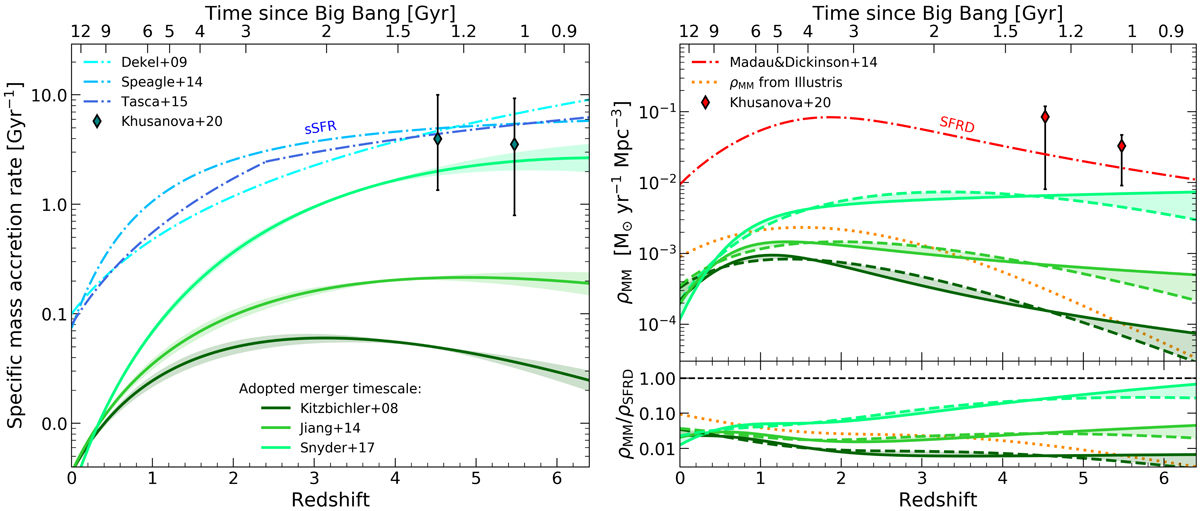Fig. 7.

Download original image
Left: comparison between the redshift evolution of the specific mass accretion rate (as derived from RMM) and the specific star formation rate. The solid lines with the shaded regions are the best-fitting functions (and corresponding uncertainties) to the same RMM data of the left panel of Fig. 5 at different merger timescales divided by the average mass ratio ![]() through cosmic time. The dot-dashed lines are several specific star formation rates from the literature (Dekel et al. 2009; Speagle et al. 2014; Tasca et al. 2015). The sSFR by Dekel et al. (2009) is normalized to sSFR(z = 0) = 0.1, as in Tasca et al. (2015). The dark cyan diamonds are the values by Khusanova et al. (2021) from the ALPINE survey. Right: Stellar mass accretion rate density (ρMM) as a function of redshift (top panel). Solid and dashed lines represent the best-fits to the data assuming double power-law, and combined power-law and exponential functions, respectively. The shaded regions highlight the uncertainties resulting from the choice of the fitting form. The colors correspond to alternative merger timescales and are the same as in the left panel. The dotted curve reports the mass accretion rate density, ρill, obtained from the Illustris simulation, as described in the text. The dot-dashed red line shows the SFRD (ρSFRD) by Madau & Dickinson (2014). The red diamonds are the total SFRD values obtained from the ALPINE survey (Khusanova et al. 2021). Bottom panel: ratio between ρMM and ρSFRD as a function of cosmic time. The dashed horizontal line marks a ratio equal to 1.
through cosmic time. The dot-dashed lines are several specific star formation rates from the literature (Dekel et al. 2009; Speagle et al. 2014; Tasca et al. 2015). The sSFR by Dekel et al. (2009) is normalized to sSFR(z = 0) = 0.1, as in Tasca et al. (2015). The dark cyan diamonds are the values by Khusanova et al. (2021) from the ALPINE survey. Right: Stellar mass accretion rate density (ρMM) as a function of redshift (top panel). Solid and dashed lines represent the best-fits to the data assuming double power-law, and combined power-law and exponential functions, respectively. The shaded regions highlight the uncertainties resulting from the choice of the fitting form. The colors correspond to alternative merger timescales and are the same as in the left panel. The dotted curve reports the mass accretion rate density, ρill, obtained from the Illustris simulation, as described in the text. The dot-dashed red line shows the SFRD (ρSFRD) by Madau & Dickinson (2014). The red diamonds are the total SFRD values obtained from the ALPINE survey (Khusanova et al. 2021). Bottom panel: ratio between ρMM and ρSFRD as a function of cosmic time. The dashed horizontal line marks a ratio equal to 1.
Current usage metrics show cumulative count of Article Views (full-text article views including HTML views, PDF and ePub downloads, according to the available data) and Abstracts Views on Vision4Press platform.
Data correspond to usage on the plateform after 2015. The current usage metrics is available 48-96 hours after online publication and is updated daily on week days.
Initial download of the metrics may take a while.


